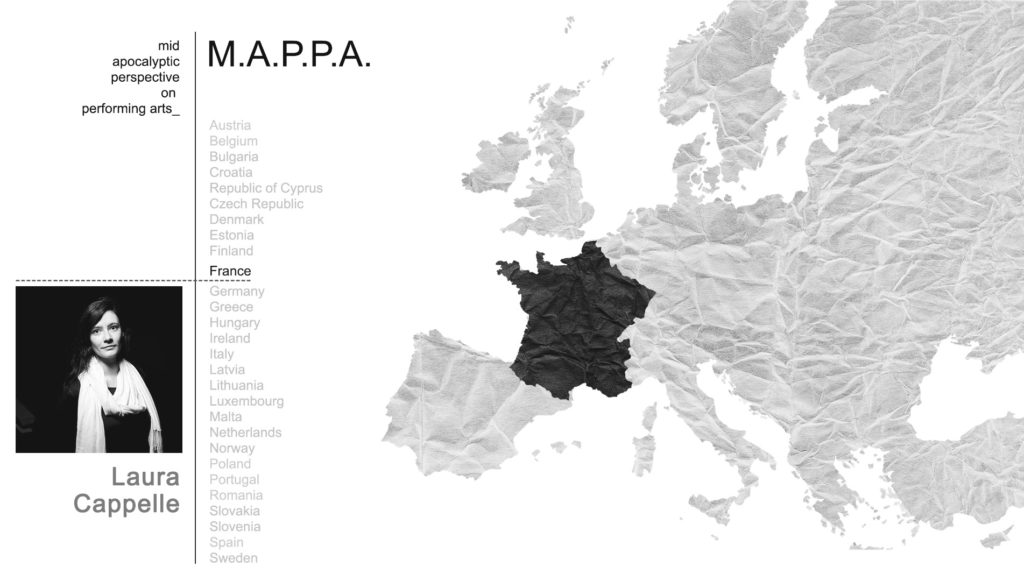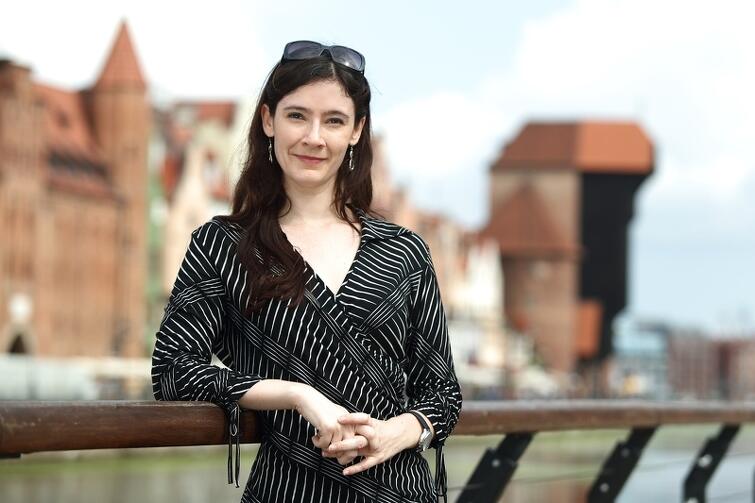
M.A.P.P.A. è un progetto di ricognizione e mappatura internazionale sulla critica dedicata alle performing arts. Abbiamo intervistato giovani giornalisti, osservatori e critici provenienti da tutta Europa.
Leggi le altre interviste di M.A.P.P.A.
Critica d’arte e sociologa, Laura Cappelle si occupa di danza per il Financial Times e di teatro francese per il New York Times. Scrive una rubrica mensile, “France / Dance”, per Dancing Times, e ha collaborato col Guardian, Pointe, Dance Magazine e Globe and Mail. Ha conseguito il dottorato in sociologia presso l’Université Sorbonne Nouvelle – Paris 3, con una tesi sul processo di creazione nelle compagnie di balletto. È stata consulente di danza per il docudrama 2015 nominato ai BAFTA Rudolf Nureyev – Dance to Freedom, diretto da Richard Curson Smith. Nel 2020, ha curato una nuova introduzione in lingua francese alla storia della danza occidentale, Nouvelle histoire de la danse en Occident (Seuil).
Quali misure sono state prese a sostegno dei lavoratori dello spettacolo in Francia?
Sebbene ci sia voluto del tempo prima che gli artisti fossero ascoltati durante il lockdown (che è durato circa tre mesi in Francia, da marzo a maggio), sono state adottate misure abbastanza complete per aiutare il settore artistico. Il ministero della Cultura ha stimato a luglio un totale di 5 miliardi di euro, anche se tale cifra include benefici a disposizione di tutti. I lavoratori del teatro hanno una serie di coperture in Francia: oltre alla retribuzione con congedo per i dipendenti a tempo pieno, i liberi professionisti che si qualificano come “intermittenti” – uno status che assicura agli artisti la possibilità di coprire le spese nelle pause fra diversi lavori, se lavorano almeno 507 ore all’anno – hanno visto il loro reddito esteso fino ad agosto 2021. Altri liberi professionisti potrebbero accedere aiuti statali fino a 1500 euro al mese, mentre prestiti e fondi di salvataggio sono stati messi a disposizione per le compagnie e le strutture.
Quali sono le misure previste riguardo alle riaperture dei teatri?
A tutti i teatri è stato permesso di riaprire dal 22 giugno, ma pochi hanno effettivamente riaperto. Molte strutture avevano già deciso di annullare il resto della stagione e si stanno concentrando sulle produzioni in cartellone per l’autunno, nella speranza che si vada avanti come previsto. Al Théâtre de la Ville, La Colline o il Théâtre de Belleville, che hanno aperto i battenti con delle rassegne estive, al pubblico degli spettacoli è stato chiesto di lasciare un posto vuoto tra i gruppi. Tuttavia, le misure di allontanamento sociale sono state rafforzate all’inizio di agosto e le mascherine sono ora obbligatorie in tutti i luoghi pubblici al coperto. Questo presumibilmente include tutti i teatri: dobbiamo ancora scoprire se ciò avrà conseguenze per la vendita dei biglietti in generale, o sulla realizzazione di spettacoli lunghi. Penso che stiamo constatando come un forte sostegno del governo per le arti possa fare la differenza nel superare una crisi straordinaria come questa: le realtà finanziate con fondi pubblici non subiranno gravi perdite anche con un pubblico ristretto.
Il periodo del lockdown ha visto molti teatri e compagnie pubblicare su internet parte dei loro archivi. Molte sono anche le performance nate online, così come si parla sempre più di residenze digitali. Persino i festival, luoghi di incontro per eccellenza, stanno proponendo un cartellone digitale. Come ti relazioni a queste modalità di fruizione?
Durante il lockdown ho passato una fase di grande difficoltà a guardare le performance digitali, come fossero un doloroso promemoria dell’impossibilità andare a teatro. Tuttavia, molti teatri e artisti hanno condiviso produzioni passate, dal Théâtre du Soleil di Ariane Mnouchkine a Laetitia Dosch, e spero che ci si sia resi conto del valore reale del rendere gli archivi disponibili. Se il balletto e l’opera hanno investito in modo consistente nello streaming negli ultimi anni, il teatro potrebbe fare molto di più per mostrare online i migliori lavori realizzati.
Ad oggi non posso dire che l’offerta online abbia rivelato un livello di creatività particolarmente sorprendente. Ciò potrebbe essere dovuto al fatto che la pandemia è stata considerata sotto controllo subito dopo il lockdown, consentendo un ritorno rapido alle esibizioni dal vivo. Penso che l’istinto di molti artisti sia stato quello di tornare ai palcoscenici tradizionali il prima possibile, invece di inventare nuove modalità di produzione “adiacenti” al teatro.
Quali sono state le pratiche performative più interessanti durante i giorni del lockdown dal tuo punto di vista?
Ciò che mi è interessato di più sono gli umili tentativi di capire quale può essere l’apporto del teatro in una crisi sociale. Ho assistito ad una delle primissime produzioni post-lockdown, uno spettacolo in stile cabaret, diretto da Léna Bréban. È stato preparato per essere messo in scena nelle case di cura e di riposo, gravemente colpite dal virus, ed è stato profondamente toccante vederlo. I valori estetici non contano molto date le circostanze: esibizioni sentite, nel posto giusto e al momento giusto. faranno molto di più per convincere il pubblico che le arti contano in tempi di crisi.
Credi che questa crisi cambierà profondamente i linguaggi, gli spazi, i temi delle arti performative?
Deve! Sono preoccupata piuttosto che si arrivi ad un sovraccarico di creazioni impulsive sul lockdown o su misteriose malattie, prima che qualcuno abbia avuto il tempo di digerire adeguatamente ciò che è successo. Anche se sarebbe del tutto comprensibile, non sono sicura che il pubblico sarà dell’umore giusto per produzioni claustrofobiche: ci vuole tempo, forse anni a partire da oggi, per elaborare un’esperienza come questa e metterla significativamente in arte.
È possibile vivere del mestiere della critica in Francia?
Io lavoro principalmente per pubblicazioni internazionali, quindi la mia esperienza potrebbe differire da quella della maggior parte degli scrittori francesi. Ci sono ancora critici professionisti di teatro e danza, ma molti sono freelancer in questi giorni e le opportunità stanno diminuendo. Proprio quest’estate, l’importante emittente radiofonica France Culture ha annunciato che un programma di punta, La Dispute, in cui i critici recensiscono le produzioni teatrali (oltre a libri, film, musica etc… ), non tornerà a settembre. A ciò si aggiunga il calo dei ricavi pubblicitari e di vendita nel panorama dei media, che non ispira esattamente ottimismo.
Che cosa ti manca di più della dimensione live delle arti performative?
Siamo immensamente fortunati che le esibizioni siano riprese, anche se sono generalmente di dimensioni inferiori, per ovvi motivi. Mi manca dunque l’energia irrefrenabile di un grande cast, l’entusiasmo di un’ambiziosa prima e il cameratismo di festival come Avignone, che è stato cancellato quest’anno (una “Semaine d’art”, a fine ottobre, è stata programmata lì con lo scopo di attutire il colpo). Molti di noi habitué adoravano lamentarsi, ogni luglio, di quanto la città diventasse affollata, costosa e snervante, e probabilmente lo faremo di nuovo l’anno prossimo: ma il Festival è anche sempre una fonte di ispirazione, oltre che un’istantanea dell’industria teatrale, nel bene e nel male. I grandi eventi tendono a promuovere un senso di connessione che è difficile da ottenere in questo momento e che lascia un vuoto.

Laura Cappelle is an arts writer and sociologist who lives in France. She has been the Financial Times’ Paris-based dance critic since 2010 and covers French theatre for the New York Times. Additionally, she writes a monthly column, “France/Dance,” for Dancing Times, and has contributed to the Guardian, Pointe, Dance Magazine and the Globe and Mail, among other publications. Laura Cappelle earned her PhD in sociology at the Université Sorbonne Nouvelle – Paris 3 in 2018, with a doctoral thesis about the creation process in ballet companies. She was the dance consultant for the BAFTA-nominated 2015 docudrama Rudolf Nureyev – Dance to Freedom, directed by Richard Curson Smith. In 2020, she edited a new French-language introduction to western dance history, Nouvelle histoire de la danse en Occident (Seuil)
What are the measures overtaken by the national government, or by the local institutions, in support of the theatre workers?
While it took time for artists to be heard during lockdown (which lasted roughly three months in France, from March to May), fairly comprehensive measures have been implemented to help the arts sector. The French culture ministry estimated in July that €5 billion would go to it in total, although that figure includes benefits available to all. Theatre workers have a range of statuses in France. In addition to furlough pay for full-time employees, freelancers who qualify for “intermittent” status – which helps artists cover costs between gigs if they work at least 507 hours per year – have seen their salary extended through August 2021. Other freelancers could access state help of up to €1500 per month, while loans and bailout funds were made available for companies and venues.
What are the dates and measures concerning the reopening of theatres?
All theatres were allowed to reopen from June 22, but only a few actually did. Many venues had already opted to cancel the rest of their season and are currently focusing on productions scheduled for the autumn, in the hope that they’ll go ahead as planned. At the Théâtre de la Ville, La Colline or the Théâtre de Belleville, which all opened their doors with special summer seasons, audience members attending a performance together have been required to leave an empty seat between them and other groups. Social distancing measures were tightened in early August, however, and masks are now mandatory in all indoor public places. That presumably includes all theatres, but we have yet to find out whether that will make selling tickets or putting on lengthy productions less viable. I do think we’re seeing how strong government support for the arts can make a difference in helping theatre weather an extraordinary crisis like this one: publicly funded venues in France don’t have as much to lose if artists play to smaller audiences.
During the lockdown, many theatres and companies published part of their archives on the Internet. Also, we have been watching many digital performances, as well as there has been an intensive talking about “digital residences”. Even the festivals, that can be seen as the most evident meeting places, are proposing a digital billboard. How do you relate to this way of enjoying the performing arts?
I went through a phase during lockdown when I found it very difficult to watch digital performances. It was a painful reminder that going to the theatre was no longer possible. Still, plenty of venues and artists shared past productions, from Ariane Mnouchkine’s Théâtre du Soleil to Laetitia Dosch, and I hope some have realised that there is real value in keeping archives that can be made readily available. Ballet and opera have invested more consistently in streaming in recent years; theatre could do a lot more to showcase the best work being made in France online.
I can’t say France brought an especially striking level of creativity to online offerings. That may be because the pandemic was considered under control after lockdown, allowing for a fairly quick return to live performances. France also has an extensive network of theatre venues around the country. They play a central role in the way the art form is funded, and I think many artists’ first instinct was to return to traditional stages as soon as possible, instead of inventing new ways to produce theatre-adjacent work.
The most interesting alternative theatrical practices you have experienced in these days
What I have enjoyed the most are the humble attempts to figure out what theatre can bring to the table during a social crisis. Shortly after lockdown ended, I attended one of the first post-Covid performances, a cabaret-style show directed by Léna Bréban. It was designed to be performed at nursing and retirement homes, which have been badly affected by the virus, and it was deeply moving to witness. Production values don’t matter much under the circumstances; heartfelt performances in the right place and at the right time will do much more to convince the public that the arts do matter in times of hardship.
Do you think the current state-of-things will affect the language, the topics, the space of the performances etc…in deep? If yes, how?
It has to. I’m worried it may lead to an overload of knee-jerk creations about lockdown and mysterious illnesses before anyone has had time to properly digest what has happened. While it would be completely understandable, I’m not sure audiences will be in the mood for claustrophobic productions any time soon, and it takes time to process an experience like this one and shape it into meaningful art. We may not understand fully how it translates into theatre until years from now.
What is the labor framework of the performance art criticism in your country?
I work mostly for international publications so my experience may differ from that of most French writers. There are still professional theatre and dance critics in France, but many are freelancers these days, and opportunities are dwindling. Just this summer, the prominent radio station France Culture announced that a flagship programme, La Dispute, in which critics review theatre productions (as well as books, films, music…), would not be back in September. Add to that the fall in advertising and sales revenues across the media landscape, which doesn’t exactly inspire optimism.
What do you miss\have you been missing most from live performances and plays?
We are immensely lucky that performances have resumed here. Still, they are generally smaller in scale, for obvious reasons. I miss the irrepressible energy of a large cast, the excitement of an ambitious premiere, and the comradery of festivals like Avignon, which was cancelled this year (a week-long “Semaine d’art” in the city is meant to soften the blow in late October). Many of us regulars love to complain every July about how crowded, expensive and tiring Avignon is, and we probably will again next year, but it also acts as a source of inspiration and a snapshot of the theatre industry – for better or worse. Bigger events tend to foster a sense of connectedness that is hard to come by right now, and that leaves a void.











